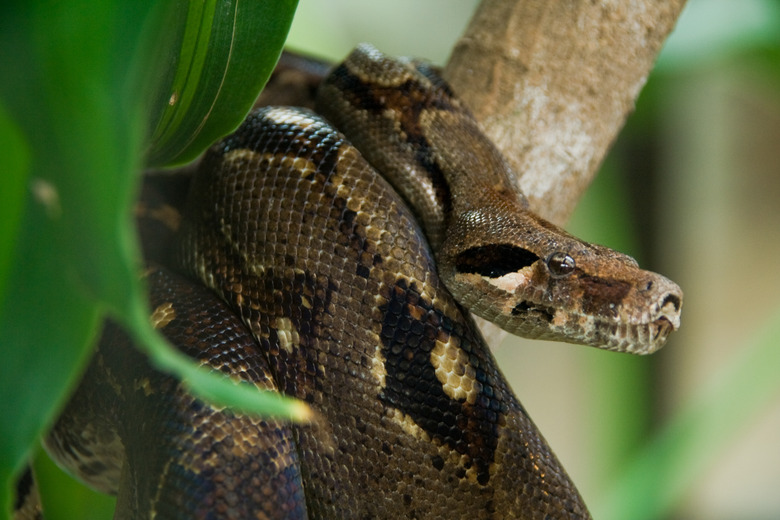What Adaptations Do Anacondas Have To Survive?
Four species of anacondas exist, with the green anaconda being the largest among all species of snakes. Anacondas can grow to lengths of nearly 38 feet and weigh over 500 pounds. Unlike some snakes, anacondas don't rely on venom to subdue their prey. Instead, anacondas use constriction to slowly suffocate their victims. While anacondas hunt on land, they prefer water to accommodate their massive bodies. These snakes have developed special adaptations to allow them to survive.
TL;DR (Too Long; Didn't Read)
Anacondas have sharp teeth, strong jaws, taste-based tracking, camouflage scales, repelling scent glands, huge size, and a large lung capacity to help them hunt.
Sharp Teeth, Strong Jaws
The shape of an anaconda's teeth act as pivotal tools for it to capture its prey. While small, an anaconda's teeth have curves and exceedingly sharp edges. Once trapped within an anaconda's jaw, escaping from its teeth escape becomes near impossible for prey. This helps the snake as it coils its body around its victims. An anaconda has stretchy ligaments within its jaw, which help the snake open its mouth wide. Since anacondas have mobile ligaments, they can easily swallow larger prey, such as capybara and jaguars. This allows an anaconda to subsist on one meal for weeks or even months.
Tracking With The Tongue
Tracking With The Tongue
Located within the roof of a reptile's mouth, the Jacobson's organ, helps it to smell, rather than taste, molecules in the air. When interested in its surrounding, an anaconda will flick its tongue into the air to collect scents around it. When an anaconda smells something, the scents transfer to the Jacobson's organ for identification. This form of scenting helps the snake locate potential prey.
Camouflage And Cloacas
Camouflage And Cloacas
The patterns on an anaconda's body help it to hide from predators. Color spotting on an anaconda also helps the snake blend into muddy waters. This allows the snake to lie stealthily in wait for animals to come closer without being identified. If an anaconda stays out of water for an extended period of time, the snake can become infested with ticks. As a result, glands around the snake's cloaca emits a horrendous smell to ward of parasites. The cloaca acts as the snake's intestinal, urinary and genital chamber, similar to that of birds and kangaroos.
The scales, or scutes, on the underside of an anaconda assist the snake when moving on land. The scales create an undulating motion, while griping the ground to propel the snake forward. Anacondas can stay submerged under water for up to 10 minutes while stalking a potential meal. An anaconda can easily subdue its prey in water by drowning it prior to eating it.
Cite This Article
MLA
Zmuida, China. "What Adaptations Do Anacondas Have To Survive?" sciencing.com, https://www.sciencing.com/adaptations-do-anacondas-survive-8367104/. 30 April 2018.
APA
Zmuida, China. (2018, April 30). What Adaptations Do Anacondas Have To Survive?. sciencing.com. Retrieved from https://www.sciencing.com/adaptations-do-anacondas-survive-8367104/
Chicago
Zmuida, China. What Adaptations Do Anacondas Have To Survive? last modified March 24, 2022. https://www.sciencing.com/adaptations-do-anacondas-survive-8367104/
